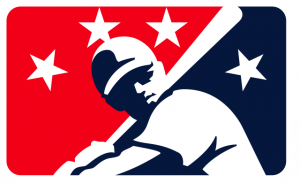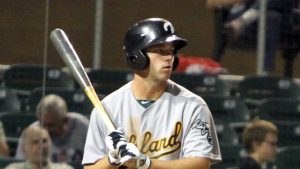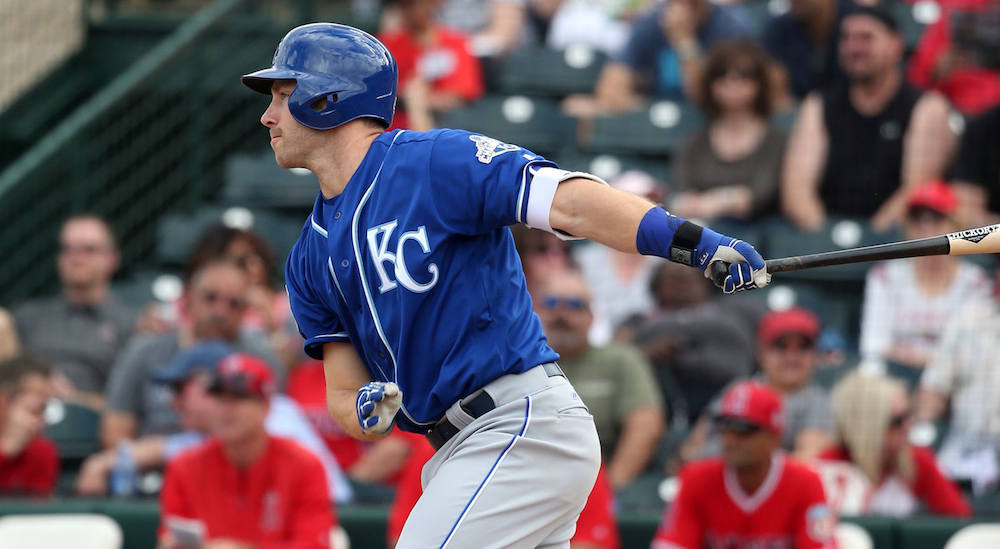Feature Photo: Dusty Coleman, INF, Padres (pictured with the Royals in 2016)
 For most minor leaguers, free agency represents the first opportunity to have some modicum of control over their careers. Players who haven’t reached the major leagues by the end of their original six-year contract often look towards free agency as their chance to find an organization with a clearer path to the big leagues than the one that they have called home for their first six years.
For most minor leaguers, free agency represents the first opportunity to have some modicum of control over their careers. Players who haven’t reached the major leagues by the end of their original six-year contract often look towards free agency as their chance to find an organization with a clearer path to the big leagues than the one that they have called home for their first six years.
The process for finding a new home isn’t that simple, however. Players often have to fight to be noticed in a crowded minor league free agent market. Although they are free to choose any team with which to sign, minor league free agents are often faced with the reality of having one – or no teams – to choose from once they are out on the market. Those that do have a choice of teams are faced with the daunting task of trying to determine which organization will present the best opportunity to reach the major leagues.
The higher you get in the minor leagues, the narrower the pipeline is for an opportunity for the big leagues,” CEO Tony Ciccolella of Excess Sports Management said.
There are generally two types of minor league free agents: those with some big league or significant Triple-A experience whose resumes sell themselves, and those who have filled more of an “organizational” role with their original teams and have often not received much playing time above the Double-A level. The players with more upper level and MLB experience often have more than one organization to choose from, while the other group can often be lucky to find one viable suitor.
Infielder Dusty Coleman (Padres) — a minor league free agent each of the past three offseasons — has experienced both ends of the minor league free agency spectrum. After six years in the Oakland A’s organization, Coleman entered the 2014-2015 free agency market looking for an opportunity in the upper levels after being stuck mostly in Double-A for three straight seasons with the A’s. It took awhile for that new opportunity to present itself. Coleman heard only radio silence for the first few months of his first free agency period. It wasn’t until January 2015 that the Kansas City Royals reached out to Coleman and signed him to a minor league deal.

Dusty Coleman, SS, Padres (pictured with Athletics in 2011). Photo by Chris Lockard.
Coleman headed back to Double-A to start the 2015 season, but his new organization ultimately meant new opportunities for him. He played his way to Triple-A Omaha and then to the big leagues, spending nearly three weeks with the Royals. He had only five at-bats during his big league stint, however, but put up career-best numbers in the minor leagues, hitting .292/.364/.442 between Double-A and Triple-A. After being designated for assignment that offseason, he decided not to test the free agency market again, and quickly re-signed with the Royals for 2016.
After not reaching the big leagues in 2016, Coleman chose to see what other opportunities were on the market. Unlike 2014 offseason, when he had to wait to get a call, Coleman received interest from several teams fairly early on in the process in 2016, and he was able to take a more systematic approach towards choosing his new baseball home. He eventually decided on the San Diego Padres, signing with the team in early December.
“The first time around, I didn’t really hear anything from anybody until January, so there was that couple of months where there was some anxiety about whether you were going to get a call,” Coleman said. “This year was different because there were two or three teams interested, so I felt like I had some choice instead of having the teams choose me. That was kind of nice and difficult at the same time.”
Coleman based his decision to sign with San Diego, in large part, because of the potential opportunity to reach the big leagues. With the Padres in a transition period as they build themselves back into contention, San Diego will have several jobs up for competition this spring. Coleman, a versatile defender, will be competing to replace utilityman Adam Rosales (3B, Athletics), who signed with Oakland on January 25.
“I can play anywhere in the infield and in the outfield, if I need to. I think that is where I am going to bring the most value to a team,” Coleman said. “That’s probably the role that I’m going to be gunning for, hopefully.”
Coleman also has some familiarity with the Padres’ organization. He has competed against San Diego farm teams for years and San Diego farm director Sam Geaney was part of the A’s player development department when Coleman was with Oakland. In addition, the scout who signed Coleman, Yancy Ayres, is now in the San Diego scouting department.
“There are a couple of players that I had played with before that I called and got their sense of the organization. Everybody had good things to say,” Coleman said. “I got a chance to talk to [San Diego manager] Andy Green and I really enjoyed talking with him as a person. I just tried to get the best sense of it. I felt like I heard good things and there is opportunity there, so I took the chance.”
Coleman knows his window for establishing himself as a big leaguer is getting smaller.
“Ultimately, at this point in my career, I looked at the depth chart and opportunity was the biggest thing for me,” Coleman said. “Just looking at it, I’m almost 30 and I want to get a chance to get back to the big leagues and be able to play up there. I thought that as the team looks right now, San Diego presented the best avenue to compete for a job.”
Right-handed pitcher Seth Frankoff (Cubs) has also had two very different journeys through minor league free agency. Frankoff spent the first five years of his career in the A’s organization, reaching as high as Triple-A Nashville in 2015. Despite a career 3.63 ERA and 439 strikeouts in 446 1/3 innings through the 2015 season, Frankoff never even received an invitation to be a non-roster player in big league camp with the A’s. Going into the 2016 season, the A’s depth chart was heavy on right-handed relievers at the upper levels, and Frankoff was released during the final days of spring training. After a week of uncertainty, Frankoff received a call from the Los Angeles Dodgers, and he quickly signed a minor league deal with them on April 5. Frankoff says that being a free agent in late March meant that he had to jump at any opportunity to remain in affiliated baseball.

Seth Frankoff, RHP, Cubs (pictured with Athletics in 2011). Photo by Chris Lockard.
“Most of the rosters were pretty much set [when he was released last spring]. It was a little bit more of a nerve-racking time,” Frankoff said. “You can’t be as selective. You need to get a job and get back out there and pitch. In that process, the Dodgers were the first to call and we went ahead and went with it because you don’t want to miss the opportunity to go out there and pitch right away.
After a solid season that was mostly split between Double-A Tulsa and Triple-A Oklahoma City, Frankoff entered the free agent market again this offseason. This time, he was able to be more selective about where he ended up. The Detroit Tigers and the Chicago Cubs expressed interest early in the process, and Frankoff ultimately signed with Chicago on November 16.
“To me, with free agency, you want to go where you are wanted. Going into it, obviously there is the monetary part of it, especially because I have gone through my original six-year contract making the minor league money. Being married, and with my wife traveling with me and that sort of stuff, the financial element definitely played a part in it,” Frankoff said. “But the most important thing for me was the room for advancement and the opportunity to pitch in the big leagues. That’s why I’m doing it. That’s why I am playing because I’m still chasing the dream and trying to get to the big leagues and stay there.”
Frankoff views the opportunity to pitch in front of the Cubs’ major league coaching staff this spring as a chance to prove that he is ready for that level.
“The last three years I had been in [A’s minor league spring] mini-camp and, while I am thankful for the opportunities I had there, there is a big difference between pitching in mini-camp and going over and backing up in big league spring games and actually being in big league camp,” Frankoff said. “That was probably the biggest sticking point for me: I wanted to be in big league camp. After three years of mini-camp with Oakland, I understood the difference between the two.”
Being able to sign early in the offseason was important to Frankoff and Coleman, as well.
“I didn’t want to go the entire offseason worrying about stuff,” Frankoff said. “I signed very early in the process because I think it is most important to go where you are wanted as a first option, and not as a second or third backup option.”
For player agents, pitching minor league clients to teams involves a lot of legwork. While the major league free agent list is readily available, the list of minor leaguers in the free agent market is long and under-publicized (with the exception of the fine folks at Baseball America, who produce a minor league free agent tracker every offseason). Teams prioritize signing major leaguers, so their needs at the minor league level may not be addressed until later in the off-season. Ciccolella, who is based in Brentwood, California and currently represents three major leaguers and numerous minor leaguers, says there is a big difference in the market for players who have had some big league or significant Triple-A time, and those who haven’t reached that level yet in their careers.
“When guys have big league experience, the GMs tend to make more phone calls and reach out to you,” Ciccolella said. “Nine times out of 10, we are able to get our guys those opportunities, but it differs a lot from the big league guys because GMs are a lot more responsive on the big league side.”
Coleman says he noticed a significant difference in how teams viewed him once he had big league experience.
“That was a big game changer. I have been on the roster and I have been in the big leagues and it helps other teams to look at me and say ‘alright, he has a little experience.’ He isn’t going to be wide-eyed the next time he gets up there,’” Coleman said. “I think that that does help in the process.”
For his clients who aren’t getting calls from teams at the outset of the free agency period, Ciccolella takes a proactive approach towards getting his clients’ names to front offices around the league. He will email a bio sheet of his clients’ stats and strengths to every team and then will follow up 48 hours later on the phone to gauge any potential interest. If the player is on a winter ball team, Ciccolella will send periodic updates to teams with that player’s winter ball stats.
One of Ciccolella’s clients, right-hander Josh Judy (Mariners), appeared in 12 games for the Cleveland Indians in 2011, but he hasn’t pitched in affiliated baseball since the 2014 season. He spent the 2015 and 2016 seasons pitching in the independent Atlantic League and then in the Mexican Summer League, looking for an opportunity to get back to affiliated baseball. Judy pitched in the Dominican Winter League this offseason, where he finished tied for first in saves with 15 and didn’t allow an earned run in 21 2/3 innings for the Aguilas de Cibaenes. Ciccolella remained in contact with teams about Judy’s success with the Aguilas and Judy recently signed a minor league deal with the Seattle Mariners on January 17. He says Judy’s winter ball performance played a key role in gaining the Mariners’ attention.
Frankoff also used his time in winter ball to strengthen his minor league free agent resume. He made eight starts this winter for the Leones del Caracas of the Venezuela Winter League and posted a 2.38 ERA in 34 innings. He believes that his performance helped to drum up interest in his services.
“I would think the way that I pitched [in Venezuela] certainly helped my case as far as free agency goes. I think it gives you more options,” Frankoff said.
Ciccolella says sometimes creativity is needed to create opportunities for his clients. In Judy’s case, the Mariners were unable to offer a non-roster invitation to big league camp, but Ciccolella pitched the idea of having Judy throw in a handful of big league spring games to showcase himself to the major league coaching staff. According to Ciccolella, the Mariners were amenable to that opportunity.
For those free agents who haven’t signed with new teams late in the offseason, Ciccolella works to get them opportunities lined up with independent league teams as a fallback option.
“In independent ball, a major league team has to buy out a player’s contract from the independent league team, but that doesn’t take effect until the first day of the independent ball league camp [generally near the end of April],” Ciccolella said. “You try to secure that independent league job just to give the player that opportunity to say that it is there if it is needed. But I keep pounding the phones all the way up until they have to report for independent ball.”
Minor league free agency can also spell the end of the road for a player’s career if teams don’t come calling. Ciccolella says six-year minor league free agents often know their major league dreams are in peril.
“Usually when you get to that point when they have played out their original contract, they are often coming to the realization that it’s not going to happen for them,” Ciccolella said. “If you get to that point, the conversations are pretty easy because they understand that they have done this for six years [without reaching the big leagues] and they are tired from the grind of baseball life. It’s unfortunate, but sometimes you have to have the conversation with those players to say ‘look, there aren’t teams that are interested in a 28-year-old guy who hasn’t played in the big leagues.’”
For those whose journeys continue, minor league free agency can become an annual event, as players jump from organization to organization, looking for that ticket to the big leagues. Many choose to take that yearly plunge into the market for years, until the calls eventually stop coming from interested teams.
While not every player finds a path to the big leagues, minor league free agency has produced numerous success stories. Brandon Moss (1B, Royals) finalized a two-year major league free agent deal with the Royals this week, but four years ago, Moss was a little-known minor league free agent. He signed a minor league deal with Oakland before the 2012 season, hit his way to the big leagues by June and quickly became a staple in the middle of the A’s lineup. Moss was an American League All-Star just two years later. Second baseman Brooks Conrad (MLB 2008-2012 & 2014, multiple teams) played six seasons in the Houston Astros’ organization before signing a minor league free agent deal with the A’s before the 2008 season. He made his major league debut with Oakland in July 2008. The next offseason, he signed a minor league deal with the Atlanta Braves, and he would play 225 games with the Braves from 2009-2011. Through 2015, Conrad had played in 293 career big league games.
Coleman, Frankoff, Judy and the scores of other minor league free agents in new organizations hope to add their names to the list of players who forged major league careers through minor league free agency.


